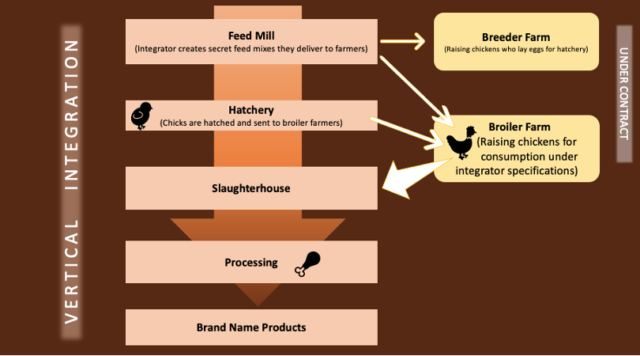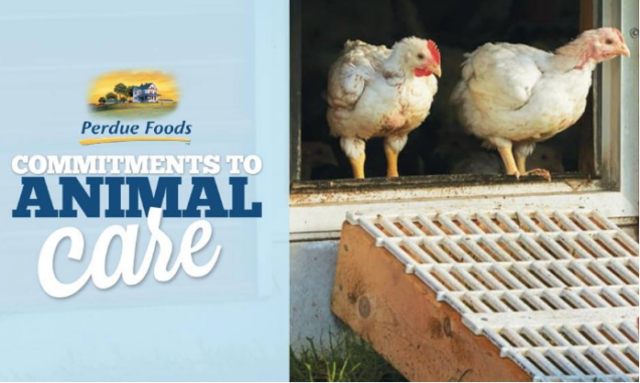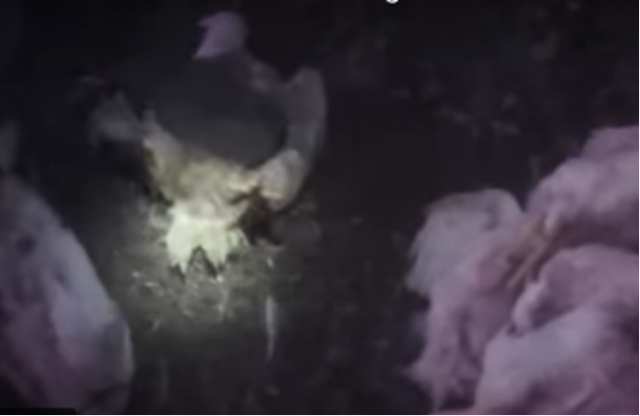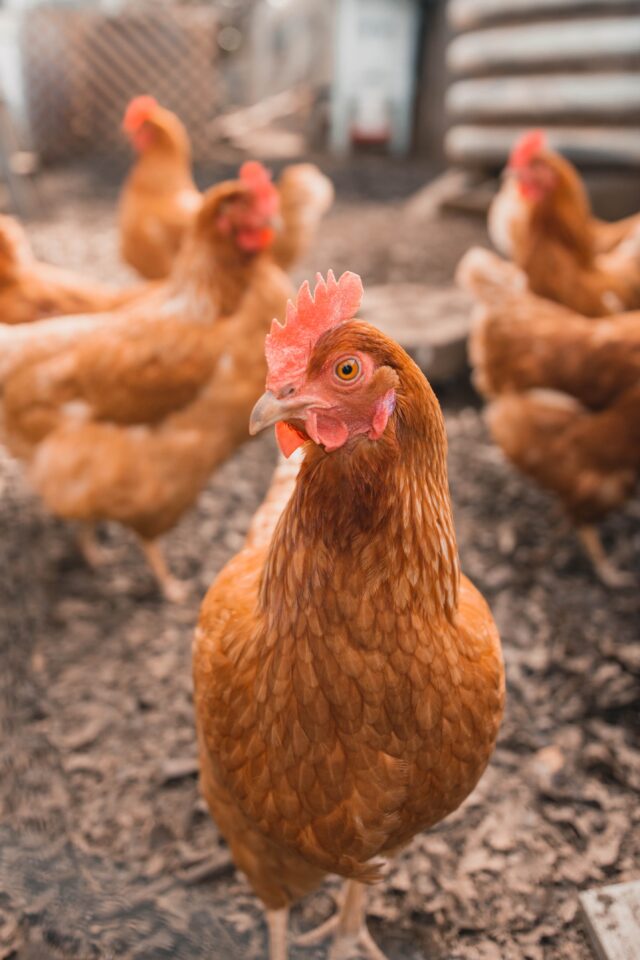America's Poultry Problem
Eating poultry is embedded into many American traditions. Americans eat 1.3 billion chicken wings on Super Bowl Sunday.1 On Thanksgiving, as many as 9 out of 10 Americans eat turkey (“America’s Bird,” as the industry terms it, “is part of our nation’s heritage”2), totaling over 46 million birds killed and eaten on a single day.3 Poultry products, and chickens in particular, constitute over 90% of the animals raised in factory farms in the U.S.4
Poultry consumption has been growing steadily, and is only projected to increase.5 Yet the chicken industry causes immense suffering to both the animals and humans involved.
The number of animals raised and killed within the poultry industry is astounding. In the United States alone, over 9 billion chickens are slaughtered every year.6 287 chickens are killed every second.7
Beyond the sheer quantity, the process of raising and killing birds creates immense suffering. Chickens raised for food, called “broilers,” are genetically modified to grow so fast their legs cannot sustain their weight (often making it impossible for the birds to reach food or water within their enclosure, resulting in their death8), and their organs often fail trying to keep up with their growth. They are overcrowded and kept in filthy, dark sheds, where they live in their own waste, suffering ammonia burns, respiratory illness, and infections. Other industry-standard practices have evolved to deal with the overcrowded conditions: de-beaking is a painful procedure where the tips of the birds’ beaks are cut off to avoid pecking other birds out of frustration; and antibiotics are used to prevent disease among the chicken population, which contributes to the growth of antibiotic resistant bacteria.9
287 chickens are killed every second.
Once the birds are ready for slaughter—a mere 6 or 7 weeks after they are born—the birds are transported to slaughterhouses on trucks, where many birds suffer bruises and injuries or are crushed to death. Once they reach the slaughterhouse, chickens are shackled upside down by their legs (sometimes breaking their legs in the process), and then stunned by passing through an electrocuted water bath or being gassed. After being stunned, the birds have their throats cut and they bleed out. Some birds are either ineffectively stunned or ineffectively cut, so they are alive and sensible when they enter the next step: the scalding tank, where their bodies are boiled to rid the carcass of feathers. After this, the carcasses are defeathered, dismembered, processed, packaged, and sent to stores.10 All of this is industry-standard and perfectly legal.
Beyond the animal suffering inherent in this industry, the human workers suffer at every stage, too.
The farmers and producers face immense financial pressure. The poultry industry is highly concentrated—only four companies dominate over 60% of the industry. Moreover, the poultry industry is vertically integrated, so large corporations control the entire production chain, from hatchery to store shelf, in order to reduce costs and maximize efficiency.11 The corporations do not own the broiler farms themselves; instead, corporations contract with farmers, which limits their own exposure to the riskiest—and least profitable—part of the production process (see Figure 1).12

Figure 1: Vertical Integration in the Poultry Industry (Source: https://www.rafiusa.org/blog/big-chicken-companies-own-and-control-everything-except-the-farm-why/).
Exploitation of poultry farmers is thus part of the industry’s design.13 The farmers who raise the birds have few options. They cannot compete with these giant integrators by processing their own birds because of market consolidation. Their facilities are often built to integrator specifications, making it nearly impossible to change paths once they enter the business.14 Nearly three quarters of contract chicken farmers live below the poverty line.15 Farmers are squeezed by the big producers and exploitative contracts into bankruptcy, leaving them with few options but to raise more chickens more cheaply.
Workers in the integrator-owned slaughterhouses, too, suffer from the psychological experience and physical exertion of slaughter. The increased demand for cheap poultry products requires increased supply, so more birds must be slaughtered per second to keep up—and the burden of increased line speed falls on slaughterhouse workers.16
Workers report the horrific smells and sights within poultry slaughterhouses:
“The plant is full of liquids. The birds produce blood, offal, and grease. Cleaning involves water, chlorine, detergent. Sometimes you spend hours on the line standing in a pool of blood.”17
Workers report a lack of breaks, even for the bathroom. Injuries often result from the repetitive motion required for a single job on the processing line (e.g., twisting and slicing wings off a carcass), and overusing dangerous equipment has even resulted in amputations.18 Slaughterhouse workers are five times more likely to suffer injuries on the job than other private workers; some estimate that as many as two thirds of slaughterhouse workers suffer from work-related injuries.19 Most recently, coronavirus outbreaks have plagued slaughterhouses as the companies failed to provide adequate safeguards for laborers.20
Moreover, many slaughterhouse workers are undocumented immigrants or minorities, which exacerbates many of these problems. These workers are far less likely to organize or complain about injuries or poor work conditions, either because of a language barrier or fear of losing their jobs, or both.21
Current Dominant Narrative
Despite all of that suffering, the industry continues to grow, and demand for poultry products continues to increase.
One main reason for such growth is a popular understanding of chickens as relatively insentient, or lacking feeling. We humans relate to chickens less than we do to other land animals, because their features and mannerisms are more foreign to us. Thus, we are less likely to identify with or acknowledge the depth or seriousness of their suffering.22 After all, the argument goes, chickens run around when their heads are cut off, so how bad could their experiences really be?
However, most consumers do care about animal welfare, and the industry is not immune to these interests. Indeed, welfarism has been promoted as the solution. Many companies (from Tyson23 to McDonalds24) have announced corporate commitments to abide by humane handling requirements. Each of the top four chicken producers maintains a strong stance supporting animal welfare on their websites.25 Animal advocates themselves often rely on welfare-based approaches, pushing for commitments to welfare rather than arguing for abolition of the animal agribusiness altogether.26
Related to these corporate commitments is the axiomatic idea of consumer choice: if people want, they can choose products produced with higher welfare. Corporations merely respond to consumer preferences and spending patterns, so the story goes. If consumers are buying a product (here, cheap poultry), then corporations are doing their job, regardless of any other consequences.
The Role of Corporate Power and Law
Corporate power both creates the condition for these industry-caused harms and perpetuates them. We see this first within the structure of the corporate form itself, where power is consolidated and integrated, yet carefully disaggregated to limit liability. Federal inspections and third-party certifications legitimate the process. Corporate power also manifests in both shallow and deep capture. The very theory of corporate law creates the conditions for exploitation of animals and people.
A. Consolidation and Vertical Integration
More than half of the entire poultry industry is controlled by four companies: Tyson, Pilgrim’s Pride, Perdue, and Sanderson Farms. This consolidation—combined with the vertical integration of the industry—allows the corporations to exploit both farmers and consumers.
Consolidated Yet Disaggregated
In corporate law, contracts are seen as both a safeguard and a scapegoat: farmers could always choose to contract differently. Yet the extreme consolidation of the industry means farmers have few options and little bargaining power. For example, the big corporations “regularly require growers to make costly equipment upgrades, sometimes for little or no reason…. Growers put up with it because in many parts of the country, there is only one processing company for chickens.”27
More than half of the entire poultry industry is controlled by four companies: Tyson, Pilgrim’s Pride, Perdue, and Sanderson Farms.
The consolidation of the industry also gives consumers the illusion of choice when shopping for poultry products. The major four companies offer dozens of products under different brand labels.28 Tyson, for example, operates familiar brands including: Tyson, Jimmy Dean, Hillshire Farm, BallPark, Wright, Aidells, and State Fair.29 Thus, while consumers may opt for more “humanely produced” chicken, the same four companies are likely pocketing the profits regardless.
Vertically Integrated Yet Disaggregated
Similarly, the vertical integration of industry is part of the design to maximize parent company profit and prevent competition from growers.30 Small farmers and players cannot access the large processing facilities, and even if they could, they could not do so without creating a significantly costlier product.
The vertical integration disaggregates responsibility within the production chain, too, creating tricky and purposefully complex chains of liability. For example, when instances of animal cruelty are uncovered at a broiler farm—often part and parcel of raising too many animals in the tight timeline mandated by the integrator—the large corporations can simply disavow the treatment of the animals and end their contract with that farmer. This response addresses the cruelty (showing consumers they “care” about the animals), and leaves the corporation largely untouched by any negative ramifications. None of this response fundamentally affects the integrator.
B. Shallow Capture
A second key way corporate power influences and protects the poultry industry is through regulatory (or “shallow”) capture. The industry has lobbied for and been protected by an almost desert-like lack of regulatory oversight of raising and slaughtering poultry. The Poultry and Egg industry—including the National Chicken Council (an industry group) and individual corporations like Sanderson Farms, Perdue, and Tyson31—spent well over a million dollars last year alone in lobbying.32
Farming Regulations
There is no federal law governing poultry being raised on a farm. State regulation varies widely, but the chicken industry has lobbied for both exemptions from laws that might protect chickens from cruel treatment and for affirmative laws protecting the industry.
Various industry-standard practices would certainly meet most states’ definition of animal cruelty: de-beaking would be a form of mutilation,33 for example. Yet most states explicitly exempt “traditional” or “common” animal husbandry practices from their criminal codes, absolving these farmers and the industry as a whole from liability.34 As some have noted, these exemptions allow the industry, rather than lawmakers, to decide which animal agribusiness practices are legal, simply by making it “common” or widely applied.35
Beyond securing exemptions from anti-cruelty laws, the poultry industry has also secured affirmative protections.
“Right to Farm” legislation, for example, often protects farmers from additional state regulatory oversight or civil liability.36 These laws are sometimes even incorporated into state constitutions, elevating the right to farm to a state constitutional guarantee.37
Similarly, “Ag-Gag” laws—anti-whistleblower statutes that to various degrees prohibit or criminalize photographing, videoing, or misrepresenting yourself in employment at an agricultural facility—have popped up around the country in response to undercover investigations.38 Various animal protection groups have succeeded in striking down these laws for violating the First Amendment, yet states continue to try new strategies for prohibiting this conduct as a way to protect animal farmers.39
Slaughter Regulations
Due to intense industry lobbying, poultry have also been exempted from Humane Methods of Slaughter Act, which is the only federal legislation addressing humane treatment of animals at slaughter. Instead, poultry slaughter is regulated under the Poultry Products Inspection Act (PPIA), which is primarily for food safety concerns.
In implementing the PPIA, however, the USDA incorporates by reference the “Good Commercial Practices”—which are set by the industry—rather than promulgating any standalone humane handling requirements.40 The Food Safety and Inspection Service (FSIS), an agency within the USDA, conducts antemortem and postmortem inspections at slaughterhouses, checking for conditions that would create food safety concerns.
These FSIS inspectors have no uniform expectations or requirements, and the rigor of inspections varies widely. Inspectors have been explicitly directed that, for example, “breaking the legs of birds to hold the birds in the shackle,” seeing birds “frozen inside the cages or frozen to the cages themselves,” or birds “dead from heat exhaustion” “do not necessarily describe prohibited activities and noncompliance” under the PPIA.41 Yet the very fact of inspection provides a third party certification which can operate to legitimize the slaughter process and comfort consumers in the quality of the product.42
There is a constant regulatory battle for the oversight of line speeds in slaughterhouses, too. In the waning days of the Trump Administration, the USDA approved line speed waivers to allow poultry plants to slaughter up to 175 birds per minute. Increasing line speeds also necessarily increases worker stress and injury, food safety violations, and inhumane handling of animals. The Biden Administration withdrew the proposed rule, stating the rule “only serve[d] to boost corporate profits while putting workers at risk.”43
Labeling Laws
The poultry industry has also captured labeling laws and regulation. Common advertising terms are mere smoke screens. For example, no broiler chickens are raised in cages, yet many chicken products are labeled “cage free.”44 The USDA regularly refuses to define other common chicken label terms, like “free range,” meaning companies can include these terms on their products without meeting any meaningful legal standards.45
These corporations can legally place these labels on their products even when the chickens are raised and slaughtered according to the industry-standard practices defined above. Labels like these are often called “humane-washing,” pacifying consumers by convincing them they are making “ethical food choices,” when in reality the corporations have the freedom to make these claims without substantiating them at all.
Since many meat eaters experience dissonance when pressed on their meat-eating habits because they acknowledge the harms to animals and people the industry imposes, having labels promising humane handling capitalizes on consumer sensitivities.46
C. Legitimation by Third Party Regulators
As discussed briefly above, chicken slaughtered for human consumption must be inspected by FSIS inspectors. There are additionally a variety of other third-party certifications that producers can obtain to show consumers they care about animal welfare, including the USDA’s Process Verified Program,47 Certified Humane,48 Animal Welfare Approved,49 Global Animal Partnership: Animal Welfare Certification,50 and more.
Having third-party accreditation lends legitimacy to the brands and the entire industry, distracting consumers from the industry-standard practices that are included in most of these certifications. This kind of regulation is actually good for the chicken industry, because it legitimates the processes of farming and slaughter and makes consumers feel better about their food choices.51
D. Deep Capture
A more complex way the poultry industry exerts power is through “deep capture”: controlling knowledge structures, promoting certain ideas, and limiting information in order to shape consumer attitudes.
Chickens Can’t Feel
A first form of deep capture can be seen in consumer attitudes about chickens, which the industry actively constructs and capitalizes on.
Chickens continue to be the most consumed animal in the U.S. year after year.52 Yet even as producing poultry has become more mechanized and industrial, many consumers nevertheless imagine backyard coops and single-family farmers. These ideas are not organic—the industry actively promotes this pastoralism.
Corporations invoke these idyllic images in their advertisements (see, e.g., Image 2 below). Compared to undercover footage of a Perdue farm showing intense confinement, piles of dead birds, and a human pressing on a live bird with his boot (see Image 3 below),53 the advertisement becomes almost farcical. “Ag-Gag” laws, discussed supra, additionally seek to criminalize capturing footage such as this, further controlling consumers’ image of agribusiness.

Figure 2: Sample Advertisement from Perdue (Source: https://corporate.perduefarms.com/).

Figure 3: Footage from Undercover Investigation at a Perdue Farm (Source: https://mercyforanimals.org/blog/perdue-worker-arrested-and-charged-with-felony/ still screenshot from 0:54, showing a boot
on a live chicken in the top left, and a pile of dead birds
in the bottom).
The industry also carefully constructs their terminology, referring to “farming birds” rather than “raising them in sheds,” for example, or “harvesting”54 rather than “killing and eviscerating.” All of these choices are deliberate, and they effect how consumers talk about—and ultimately think about—animals raised for food.
Many people eat animals because they think they must, for nutritional value. This concept, too, can be traced to industry influence. The meat industry has lobbied extensively for the primacy of meat in the U.S. Dietary Guidelines, which many people learn in elementary school. Meat and poultry continue to be lauded as an important part of a balanced diet, despite many studies showing that decreasing consumption of meat offers health benefits.55
Additionally, consumers are increasingly distant from the very fact of slaughter when they choose an animal product in a store or at a restaurant. Most consumers find markets filled with chicken cuts and processed products, making it even harder to see the bird that created the meat.56 We disaggregate the chicken into its parts—wings, thighs, breast, etc.—forgetting to pay attention to the singular creature whose flesh is shrink-wrapped on the shelf.
To the extent consumers pay attention to animal cruelty, many are comforted by corporate welfare pledges, labels assuring humane standards, and the like.57 Industry-standard practices are thus incorporated into many consumers’ minds as the “best option,” or as the most humane way raise animals for food, when in reality these practices are exactly that: industry standard.
We disaggregate the chicken into its parts—wings, thighs, breast, etc.—forgetting to pay attention to the singular creature whose flesh is shrink-wrapped on the shelf.
Many consumers moreover see chickens as less sentient or less likely to suffer from cruelty than other animals killed for food. The way consumers—and the general public—categorize animals for food is a self-justifying process.58 Studies have shown that humans resolve some of the dissonance that comes from eating meat by deemphasizing “morally relevant capacities” of animals raised for food, like the ability to feel pain, allowing us to “avoid[] discomfort” and “facilitate meat consumption.”59 The poultry industry capitalizes on this self-motivated, self-justifying understanding of chickens as unfeeling sources of protein.
Spectacular Enforcement as Distraction
Another form of “deep capture” is evident when we consider how corporations do respond to grotesque instances of animal cruelty in farming and slaughtering chickens.
Undercover investigations almost always highlight “extreme” violence. In one undercover investigation of a Pilgrim’s Pride contracted farm, for example, activists captured footage of birds being thrown across the sheds, suffering from ammonia burns and languishing, too sick to walk, and dumped into pits and left to die.60
Responding to this revealing footage, Pilgrim’s stated that “The actions in the video are unacceptable,” and reiterated that they “will not tolerate the abuse of animals.”61 Pilgrim’s suspended its relationship with the contracted farmer, and conducted an internal investigation.62 Pilgrim’s—and many other chicken producers—rely on a “bad apple” theory, distancing themselves from any responsibility when something like this comes to light. Indeed, Pilgrim’s proclaims a “zero-tolerance policy for abuse of any kind.”63
Consumers, too, can condemn the extraordinary violence while ignoring the typical violence of slaughter. Many consumers are comforted, rather than moved to reduce consumption, thinking variations of: “At least I buy from a different company.” Moreover, with the four main poultry companies operating under several different brand names, it can be hard for consumers to tie any given act of animal cruelty to the corporate power behind it. Even if consumers stop buying one brand of chicken, for example, they may continue buying other chicken products raised and slaughtered in the same facility by the same company without realizing.
And of course, the people who take the fall for perpetrating such “extreme” violence are often undocumented workers, low-level employees, or other disempowered people in the corporate chain. Having someone to blame creates a public catharsis, allows prosecution and legal theater to legitimize the outcomes, and allows the systems of the large parent corporations to continue unabated.64 The spectacle of accountability, and the performative value of legal consequences, do a lot of work to legitimate and sustain animal agribusiness when this type of footage arises.
Most insidiously, these types of investigation responses rely on and reinscribe an implicit difference between “abuse” and “standard farming practices” that undergirds the entire industry. Stepping on a bird constitutes abuse, but debeaking them without anesthetics does not;, throwing birds across a room is abuse, but breaking their legs to shackle them for slaughter is not; burying birds alive is abuse, but slitting their throats is not. The distinction between spectacular harm and routine violence seems tenuous at best, illogical and arbitrary at worst. Yet every time these corporations disavow the extreme forms of violence, they also reaffirm that routine violence of slaughter is tolerable and even good.
Thus, these undercover investigations—and the company’s responses to them—may thus actually perpetuate the ongoing system of animal and human exploitation. Even after information and footage comes to light, the industry actors are positioned to control the messaging and reaffirm the validity of their own actions, maintaining the status quo.
E. Corporate Theory
Finally, the very theory underlying corporate law—that corporations serve shareholders alone—perpetuates many of the harms caused to other stakeholders.65 Such an assumption ignores the animals and their interests, the workers and their wellbeing, the farmers, the environment, and the consumers. Rather than attending to these other stakeholders, corporate law allows and fosters an attention only to shareholders, to profit maximization, and to efficiency.
Each of the big four corporations within the poultry industry—Tyson,66 Perdue,67 Pilgrim’s Pride,68 and Sanderson Farms69—nevertheless positions themselves in advertisements and on their websites as responsive to animal welfare concerns, promoting themselves as agents of social responsibility. Perdue, for example, has emphasized its “people first” management strategy, emphasizing how it takes care of its contracted producers and farmers, even as it relies on and exploits those contracts to make $7 billion in annual revenue.{{Mike Rocheleau, In the C-Suite: Jim Perdue, Del. Business Times (Nov. 9, 2020), https://delawarebusinesstimes.com/news/c-suite-jim-perdue/?linkId=104204071.
The corporate goal of maximizing profit—under the guise of meeting ever-growing consumer demand—allows companies to continue to increase production, squeezing farmers and creating more harm to the animals, all to improve the bottom line for their shareholders.
Conclusion
Corporate law is undoubtedly a driver of many of the injustices perpetrated in the chicken industry. The way the industry has consolidated, its vertical integration, the shallow regulatory capture the ultra-powerful industry has lobbied for, and the prized place of poultry in America’s hearts and stomachs all lead to a massive industry that exploits humans and animals with few checks.
Further Reading
Jonathan Safran Foer, Eating Animals (2009).
Leah Garces, Grilled: Turning Adversaries into Allies to Change the Chicken Industry (2019).
Maryn McKenna, Big Chicken (2017).
Peter Singer, Animal Liberation: The Definitive Classic of the Animal Movement (1975).
Zephyr Teachout, Break ‘Em Up: Recovering Our Freedom from Big Ag, Big Tech, and Big Money (2020).
Dan Wirzba, Food and Faith: A Theology of Eating (2011).
